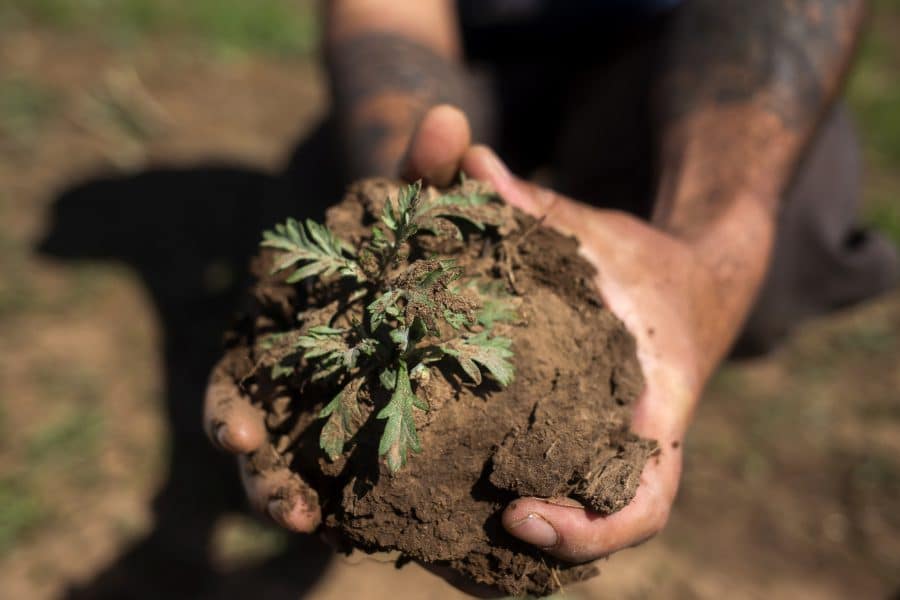The four medicines — séma (tobacco), kishki (cedar), wabshkebyek (sage) and wishkpemishkos (sweet grass) — hold extreme importance with Nishnabé and other Native Americans. However, the wide use of one popular species of sage native to California has negative ecological consequences.
“California sage cannot handle everybody’s spiritual needs,” said Kaya DeerInWater, Citizen Potawatomi Nation community garden assistant. “California white sage population is in a decline, but because of a shift that has taken place, people really only associate sage with the white sage from California: Salvia apiana.”

Before ceremony and in daily practice, Potawatomi use wabshkebyek to purify.
“There is science behind it that actually says sage does clean. It kills bacteria,” DeerInWater said. “It is a spiritual, sacred plant and a sacred medicine.”
Retail implications
Most sage bundles sold in stores and online came from a four to five-county radius in coastal Southern California. Before westward expansion and the development of roads and trade routes, people relied on the medicines native to their areas and were not dependent upon one species.
“The Sierra Mountains are huge. Getting trade routes over into Nevada just wasn’t worth it,” DeerInWater said. “It’s not like if you had a horse and buggy that you were going to travel and get a whole bundle full of sage and carry that everywhere you were; you’d just get the sage that you had.”
Rather than incorporating traditional gathering techniques, industrial approaches include harvesting entire hillsides and large acreages at a time to meet customer demands.
“It’s not like people are going, offering séma (tobacco) and trimming,” DeerInWater said. “It’s more like poaching — wholesale poaching. Teams of people are ripping up all shrubs out of the ground, then throw them in dumpsters and cart them back to sell.”
Cutting all leaves and stems above the soil keeps new California white sage plants from developing.
“Harvesting can be good, but obviously, too much harvest is bad, and there is a technique for every plant; and everything that you do, there is a way that is beneficial and a way that is not beneficial,” DeerInWater said. “The way the current system is for California white sage is not beneficial at all.”
The growing population and urbanization of California’s countryside also has negative implications on availability as well as wildfires and mudslides.
“Simply put, it is not a good situation, and many Native folks from California have voiced their concern. They’ve asked Native people and Indigenous folks to find their own sage,” he said.
Ways to help
“It’s about education. Mistakes happen. That is how it goes, but it is what you do after the mistakes and how you react that makes the difference,” DeerInWater explained. “I’m not trying to shame people for using California white sage because most people don’t know the difference, and that’s not their fault.”
DeerInWater encourages Tribal members to find local suppliers, or at the very least, investigate where and how the product is cultivated and harvested.
“Know where your sage comes from,” DeerInWater said. “It’s not something to be taken lightly, but it’s also not something that we should take super seriously. Don’t get so serious you can’t laugh at yourself, but if you have the luxury to do something about it, do it.”
Foraging native, local medicines is another way to take conservation efforts a step further. The United States Department of Agriculture’s plant database serves as a resource to learn about vegetation found across the United States down to a county-by-county level. Sage is usually ready for harvest late summer, but keep in mind, removing plants and objects from protected land is illegal. Also, avoid fields and roadsides where chemical use is prevalent.
“Don’t gather under power lines or anywhere near power lines because they get sprayed regularly, and there is about a 10-yard buffer,” DeerInWater said. Also, forage only when in a good mood to avoid introducing negativity into the plants picked.
“I usually won’t harvest more than one-third of a patch,” he said. “Basically, don’t take it all. That’s part of our philosophy as Indigenous folks and Nishnabé folks as well.”
Shopping for regional sage at a local nursery provides another option as well as transplanting from the wild.
“Find somewhere it grows and offer séma (tobacco), or whatever protocol you follow, ask for permission, let the plant know what your intentions are for harvesting it, and then dig it up and take it home,” he said.
For those living in or visiting Oklahoma, the Bodewadmi Widoktadwen Gtegan (Potawatomi Community Garden) has a select number of sage plants — species Artemisia ludoviciana — that is native to the area. Earlier in 2019, staff and volunteers dug and potted for the benefit of CPN members. DeerInWater encourages those interested to stop by the garden.
“It’s about respect – respect for segmekwé, our Mother Earth. If we know that something is hurtful, then obviously, we shouldn’t do it,” DeerInWater said. “We traditionally view plants as our relatives and kin. You wouldn’t hurt your grandma purposefully, so why would you hurt the plants purposefully?”
Learn more about Bodewadmi Widoktadwen Gtegan events and workshops at cpn.news/events.
